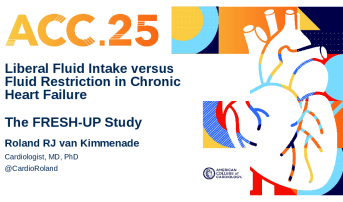Tight Fluid Restriction Not Needed in Chronic HF Patients: FRESH-UP
Liberal fluid intake was safe and suggestive of better health status: this should be enough to stop restricting patients to 1.5 L.

CHICAGO, IL—Patients with chronic heart failure (HF) should not feel compelled to limit the amount of fluids they take in during the day, according to results of the FRESH-UP study.
A more liberal fluid-intake approach was associated with more favorable health status, reduced thirst, and no signal of harm at 3 months when compared with the traditional restrictive approach, researchers reported this week at the American College of Cardiology Scientific Session.
“This study was really inspired by the patients,” senior investigator Roland van Kimmenade, MD, PhD (Radboud University Medical Center, Nijmegen, the Netherlands), told TCTMD. “Usually when you do research, you investigate a disease and you discover a mechanism and then you develop medication or tools to improve the outcomes of the disease. This was really a patient-driven study. Patients said: ‘You are giving us this advice. I don’t like it. Why are you giving it? How is it helping me?’”
The 2022 American Heart Association/American College of Cardiology/Heart Failure Society of America guidelines acknowledge that fluid restriction is commonly recommended for HF patients, but say “evidence in this area is of low quality.” Cutting back on fluids also has a “limited-to-no” effect on clinical outcomes or use of diuretics, according to the guidelines.
Fluid restriction, said van Kimmenade, is “something that really bothers [patients].”
No Sign Restrictive Intake Helps
The FRESH-UP study, which was reported during a late-breaking clinical trial session and simultaneously published in Nature Medicine, is the largest randomized trial to date investigating liberal fluid intake versus a restrictive approach.
The study included 504 chronic HF patients (mean age 69 years; 33% women), the majority with NYHA class II symptoms, and randomized them to a fluid maximum of 1,500 mL per day or no restrictions. Patients were matched between groups and well-treated with guideline-directed medical therapy, including SGLT2 inhibitors. Patients with unstable HF, those recently hospitalized, and patients with hyponatremia were excluded from the study.
After randomization, the median patient-reported fluid intake was higher in those assigned to no restrictions (1,764 mL vs 1,488 mL). In the liberal intake group, 74.2% and 34.3% drank more than 1,500 and 2,000 mL per day, respectively, compared with 42.6% and 4.8% in the restricted arm, respectively.
At 3 months, there was no significant difference in the Kansas City Cardiomyopathy Questionnaire overall summary score (KCCQ-OSS), a measure that tracks symptom severity, symptom frequency, physical limitations, and quality of life. The trend, however, favored liberal-fluid intake: KCCQ-OSS 74.0 vs 72.2 with fluid restriction (P = 0.056).
Speaking with the media, van Kimmenade said the mean difference in KCCQ-OSS after adjusting for baseline scores was 2.17 (95% CI -0.06 to 4.39), with the confidence interval almost ruling out the possibility that fluid restriction could be the better approach.
“There’s not a signal that there is any benefit from fluid restriction,” said van Kimmenade.
There was a significant improvement in the KCCQ clinical summary score, a measure of symptoms and physical limitations of living with HF, in the liberal fluid intake group. Additionally, thirst distress was significantly higher in the restricted group. The liberal-fluid recommendation was not linked with any adverse outcomes, including no differences in mortality, hospitalizations, use of intravenous loop diuretics, acute kidney injury, or changes in loop diuretics.
Let's be a little kinder to our patients and ourselves. Shelley Hall
Shelley Hall, MD (Baylor Scott & White Health, Dallas, TX), commended the FRESH-UP investigators for conducting a study that will impact clinical practice. Many physicians, she said, were skeptical of recommendations to reduce fluid intake down to 1,500 ml per day.
“We can't manage volume in the hospital, and yet we are trying to put stricter restrictions on our patients,” she said. “I was actually delighted to see the results of this trial [to be able to say] we were right: 2 liters is absolutely fine.”
Hall noted there was a “placebo effect” in the trial, noting that even those randomized to no restrictions kept their fluid intake below 2,000 mL. Nonetheless, the trial clearly demonstrates that patients put on restricted fluids are thirsty, which is mentally taxing. “What I would take away from this trial is let's be a little kinder to our patients and ourselves, that we don't probably have to be so harsh in pounding fluid restriction,” she said, adding that a good recommendation would be to tell patients to drink to quench your thirst, but not whatever you want.
Michael O’Riordan is the Managing Editor for TCTMD. He completed his undergraduate degrees at Queen’s University in Kingston, ON, and…
Read Full BioSources
Herrmann JJ, Brunner-La Rocca HP, Baltussen LE, et al. Liberal fluid intake versus fluid restriction in chronic heart failure: a randomized, clinical trial. Nat Med. 2025;Epub ahead of print.
Disclosures
- van Kimmenade reports consulting fees from Novo Nordisk and Roche Diagnostics.






Comments